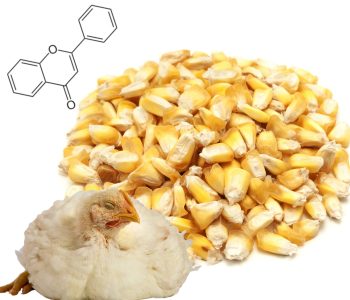Corn with high flavonoid content appears to hold great productive advantages in poultry diets. The addition of corn with high flavonoid content to broiler diets can help reduce the onset of intestinal disease. The following is a review of a study carried out assessing this topic at Pennsylvania State University, USA.
According to the assistant professor of poultry and avian health in the Faculty of Agricultural Sciences, the obtained results are especially important because they come at a time when poultry producers are reducing their dependence on antibiotics to keep birds healthy.
| Due to concerns about the emergence of antibiotic-resistant pathogens, producers need help in finding alternative ways in which they can keep diseases amongst their flocks at bay. |
Necrotic enteritis is one of the most devastating diseases of poultry. This intestinal disease, mainly affecting broilers of a few weeks, produces enormous economic losses. It is estimated that the disease can cost millions of dollars a year worldwide due to losses in productivity, treatment and prevention costs.
Experimental design
The study was conducted over a 21 day period, using a randomized design with 4 treatments. A total of 400 400-day broilers(Ross 308) were evaluated.
Upon arrival, the birds were distributed according to the following treatments:
- CTL A (uninfected birds fed a commercial corn-based diet)
- CTL B (uninfected birds fed a PennHFD-based diet)
- INF A (birds co-infected with Eimeria maxima and Clostridium perfringens and fed a commercial corn-based diet);
- INF B (Birds co-infected with Eimeria maxima and Clostridium perfringens and fed a PennHFD-based diet)
The feed used in this study was manufactured at the Center for Poultry Education and Research at Pennsylvania State University. Two diets were formulated with the inclusion of ingredients recognized as important predisposing factors for necrotic enteritis in broilers: wheat and fishmeal.
Diets differed by the type of corn:
› “Dieta A” was formulated with commercially available corn.
› “Dieta B” was formulated with a patented corn (PennHFD), containing a rich flavonoid content.
To estimate flavonoid content, the relative concentration of flavilum ions was measured in order to compare PennHFD and commercially available corn lines. Flavilum ions are a byproduct derived from the extraction method of flavonoids. The methodology described by Grotewold et al., (1998) and wu et al., (2021) was followed to make such determinations.
Discussion
The use of antibiotics as growth promoters has been steadily declining in poultry production and alternatives such as flavonoids have been presented as a potential replacement. In the previously mentioned experiment, the inclusion of flavonoid-rich corn reduced mortality and the presence of indicative lesions for necrotic enteritis (NE) in broilers.
⇒ In the present study, those birds which received PennHFD and were challenged with C. perfringens (INF B) had a lower mortality rate and a lower incidence of intestinal lesions. These also presented improvements in body weight gain (BWG) and feed conversion rate (FCR) compared to those fed with the INF A treatment.
These results coincide with those obtained in previous studies. Where the inclusion of phytogenic additives in birds undergoing necrotic enteritis resulted in a higher growth yield, and a reduction in mortality and C. perfringens.
» Although this study did not delve on the mechanisms of action through which flavonoid-enriched corn to reducing necrotic enteritis in chickens, researchers believe that the anti-inflammatory and antibacterial properties of flavonoids play a key role in controlling this disease.
They suggested that the use of corn with a high flavonoid content may be an effective alternative for improving chickens’ health and performance in the absence of antimicrobials. It is for such reason that Penn State has applied for a provisional patent of their PennHFD feed as a poultry therapy.
SOURCE: ScienceDirect. Inclusion of high-flavonoid corn in the diet of broiler chickens as a potential approach for the control of necrotic enteritis 2022.
